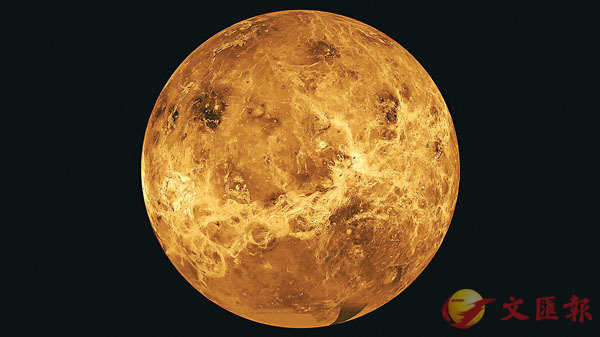 ■天文學家在金星發現疑似存在生命的跡象。 資料圖片
■天文學家在金星發現疑似存在生命的跡象。 資料圖片【原文】下文摘錄自香港《文匯報》9月16日報道:
天文學家(astronomer)日前在距離地球最近的行星金星(Venus),發現疑似存在生命的跡象。英國、美國與日本天文學家組成的團隊,前日在《自然天文學》(Nature Astronomy)期刊發表報告,指出在金星大氣層(atmosphere),發現高濃度磷化氫(phosphine)氣體,且未能解釋源頭。由於地球的磷化氫多由動物與微生物活動產生,今次發現可能顯示金星存在生命,美國太空總署(National Aeronautics and Space Administration, NASA)形容,這次或是尋找外星生命(extraterrestrial life)的最顯著進展。
團隊利用位於美國夏威夷(Hawaii)及智利(Chile)的天文望遠鏡(astronomical telescope),通過光譜觀測(spectral observation),在金星大氣高層中,發現磷(phosphorus)的化學特徵,最終確認發現的化學物質為磷化氫,在大氣中的濃度約為十億分之二十。
天文學家在各個行星(planet)尋找生命跡象時,主要方法之一是尋找只能通過生物活動產生的化學物質,即「生物標誌」(biomarker),磷化氫正是其中之一。在地球上,磷化氫除工業生產排放外,主要通過厭氧微生物(anaerobic bacteria)繁殖(reproduction)產生,在沼澤、池塘底部、還有許多生物的內臟和排洩物中,都存在磷化氫。
金星與地球的大小和質量(mass)接近,但因與太陽距離太近,地表溫度(surface temperature)可達攝氏400度以上,足以融化金屬,故一直被認為很難存在生命,人類過去的太空探索(space exploration)對象,亦普遍是較冷的火星(Mars)。
不過科學家指出,距離金星地表約5萬米高的高層大氣溫度約攝氏30度,儘管金星大氣酸度(acidity)達90%,部分能夠適應極端酸性環境的微生物(microbe),依然有機會藏身懸浮水滴中,吸收陽光和水維生。這也意味即使是表面環境遠比地球惡劣的星球,亦可能有生命存在。
領導研究的卡迪夫大學(Cardiff University)天文學家格里夫斯(Jane Greaves)表示,團隊已調查在金星上產生磷化氫的非生物潛在來源,例如火山活動、隕石(meteorite)、閃電和各類型化學反應,但仍未找到確實來源,形容對研究結果感到非常意外。有份參與研究的曼徹斯特大學(University of Manchester)天文學家理查德茲(Anita Richards)認為,金星大氣或存在「極易與磷化氫反應的物質」,並不斷產生磷化氫,才能達到現有磷化氫濃度。
另一名參與研究的麻省理工大學(Massachusetts Institute of Technology)分子天體物理學家(molecular astrophysicist)席爾瓦(Clara Sousa-Silva)形容,按照人類對金星的認識,「對磷化氫存在最有可能的解釋聽來很夢幻,就是存在生命。」
不過席爾瓦強調,在太空探索過程中,「生命」永遠要放在最後一項可能解釋,現有知識未能解釋金星大氣中存在磷化氫的原因,也不等於證明金星就存在生命,「我們對於金星的認知需要繼續進步。幸運的是,金星離我們並不遠,我們完全可以前往查看。」
格里夫斯亦稱,研究結果不代表金星存在生命,但承認是首次在地球以外的類地行星(terrestrial planet)發現磷。
美國太空總署正計劃在2030年代,向金星發射探測器(probe),屆時或會以顯微鏡(microscope)尋找生命,外界估計今次發現,可能引發人類新一輪的金星探索活動。
Phosphine in the clouds of Venus initiates a rhapsody of life
【譯文】Astronomers discovered a potential sign of life on Venus, the closest planet to Earth. An international team of British, American and Japanese astronomers recently released a report in the scientific journal Nature Astronomy, pointing out that an extremely high concentration of phosphine was found in the atmosphere of Venus but the chemical's presence remained a mystery. As phosphine on Earth is mostly produced by animal and microbial activities, such finding might indicate an existence of life on Venus. The National Aeronautics and Space Administration (NASA) described the discovery as the most significant development yet on the search for extraterrestrial life off Earth.
By using astronomical telescopes in Hawaii, U.S. and Chile, the team found the chemical characteristics of phosphorus in the upper atmosphere of Venus through spectral observations, and eventually confirmed that the chemical substance discovered was phosphine at concentrations of up to 20 parts per billion in the atmosphere.
When astronomers are searching for signs of life on various planets, one of the methods used is to look for the chemical substances that can only be produced through biological activities, i.e. "biomarkers", and phosphine is regarded as one of the important indicators. Aside from industrial emissions, phosphine on Earth is believed to be created mainly by the reproduction of anaerobic bacteria and it can often be found in swamps, at the bottom of ponds and inside the viscera and faeces of many organisms.
Venus has the size and mass comparable to that of Earth. Yet, due to its close proximity to the Sun, its surface temperature can reach up to over 400 degrees Celsius, which is hot enough to melt metal. Therefore, it has long been considered too hot to harbor life, and the general target of human space exploration in the past had been the relatively cold Mars instead.
However, scientists pointed out that the temperature of the high clouds of Venus, which is about 50,000 meters above its surface, reaches a pleasant 30 degrees Celsius. Although the acidity of the Venus' atmosphere is as high as 90%, microbes adaptable to extremely acidic environments might still be able to hide inside the suspended droplets and survive by absorbing sunlight and water, meaning that any planet whose surface environment is far worse than that of Earth might still be possible to support life.
Jane Greaves, an astronomer at Cardiff University who led the observations, said that the team had investigated the potential non-biological sources of phosphine on Venus, such as volcanic activity, meteorites, lightning and various types of chemical reactions, but the presence of such chemical was still a mystery, saying that the discovery was really very unexpected.
Another researcher, Anita Richards of the University of Manchester, believed that the planet's atmosphere might contain substances that were extremely easy to have chemical reactions with phosphine, and continuously produced the gas to reach such high concentrations.
With respect to the existence of phosphine on Venus, another research scientist Clara Sousa-Silva, a molecular astrophysicist at the Massachusetts Institute of Technology, said that "as crazy as it might sound, our most plausible explanation is life."
However, Sousa-Silva emphasized that during the process of space exploration, "life" should always be the last possible explanation as the current knowledge failed to explain the presence of phosphine in the clouds of Venus, and it did not mean that there was life. "Our understanding of Venus needs work. Fortunately, Venus is right next door so we can literally go and check", she added. Jane Greaves echoed that the finding did not necessarily imply that life did really exist on Venus, but admitted that phosphine was first spotted on a terrestrial planet other than Earth.
NASA is going to launch probes to Venus in the 2030s in search for life by using microscopes. It is expected that the discovery of phosphine on Venus may trigger a new round of space exploration for the planet.■龐嘉儀
Q&A
1. 金星在中國古代稱為什麼?
2. 金星的天文符號「♀」的含義是什麼?
3. 金星稠密的大氣層主要由什麼組成?
Answer
1.太白、明星或大囂
2. 維納斯的梳妝鏡
3. 二氧化碳(Carbon dioxide)

